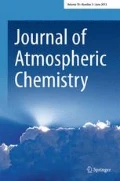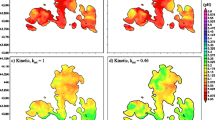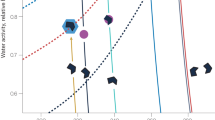Abstract
Partitioning of volatile chemicals among the gas, liquid, and solid phases during freezing of liquid water in clouds can impact trace chemical distributions in the troposphere and in precipitation. We describe here a numerical model of this partitioning during the freezing of a supercooled liquid drop. Our model includes the time-dependent calculation of the coupled processes of crystallization kinetics, heat transport, and solute mass transport, for a freezing hydrometeor particle. We demonstrate the model for tracer partitioning during the freezing of a 1000 μm radius drop on a 100 μm ice substrate, under a few ambient condition scenarios. The model effectively simulates particle freezing and solute transport, yielding results that are qualitatively and quantitatively consistent with previous experimental and theoretical work. Results suggest that the ice shell formation time is governed by heat loss to air and not by dendrite propagation, and that the location of ice nucleation is not important to freezing times or the effective partitioning of chemical solutes. Even for the case of nucleation at the center of the drop, we found that dendrites propagated rapidly to form surface ice. Freezing then proceeded from the outside in. Results also indicate that the solid-liquid interfacial surface area is not important to freezing times or the effective partitioning of chemical solutes, and that the rate aspects of trapping are more important than equilibrium solid-liquid partitioning to the effective partitioning resulting from freezing.
Similar content being viewed by others
References
Abbatt, J. P. D., 2003: Interactions of atmospheric trace gases with ice surfaces: Adsorption and reaction. Chemical Reviews 103, 4783–4800.
Audiffren, N., Cautenet, S., and Chaumerliac, N., 1999: A modeling study of the influence of ice scavenging on the chemical composition of liquid-phase precipitation of a cumulonimbus cloud. Journal of Applied Meteorology 38, 1148–1160.
Atkins, P. W., 1990: Physical Chemistry, 4th ed., Freeman, W. H. and Co., New York.
Barth, M. C., Stuart, A. L., and Skamarock, W. C., 2001: Numerical simulations of the July 10, 1996, Stratospheric-Tropospheric Experiment: Radiation, Aerosols, and Ozone (STERAO) - Deep Convection experiment storm: Redistribution of soluble tracers. Journal of Geophysical Research 106(D12), 12381–12400.
Bird, R. B., Stewart, W. E., and Lightfoot, E. N., 1960: Transport Phenomena, John Wiley & Sons, Inc., New York.
Bolling, G. F. and Tiller, W. A., 1961: Growth from the Melt. III. Dendritic Growth. Journal of Applied Physics 32(12), 2587–2605.
Burton, J. A., Prim, R. C., and Slichter, W. P., 1953: Journal of Chemical Physics 21, 1987.
Caroli, B. and Muller-Krumbhaar, H., 1995: Recent advances in the theory of free dendritic growth. ISIJ International 35(12), 1541–1550.
Chatfield, R. B. and Crutzen, P. J. 1984: Sulfur dioxide in remote oceanic air: Cloud transport of reactive precursors. Journal of Geophysical Research 89(D5), 7111–7132.
Chen, J.-P. and Lamb, D., 1990: The role of precipitation microphysics in the selective filtration of air entering the upper troposphere. In. 1990 Conference on Cloud Physics, pp. 479–484, Am. Meteorol. Soc., Boston, Mass.
Chen, J.-P. and Lamb, D., 1994: Simulation of cloud microphysical and chemical processes using a multicomponent framework. Part I: Description of the Microphysical Model. Journal of the Atmospheric Sciences 51(18), 2613–2630.
Cho, H. R., Niewiadomski, M., and Iribarne, J., 1989: A model of the effect of cumulus clouds on the redistribution and transformation of pollutants. Journal of Geophysical Research 94(D10), 12895–12910.
Clegg, S. M. and Abbatt, J. P. D., 2001: Oxidation of SO2 by H2O2 on ice surfaces at 228 K: A sink for SO2 in ice clouds. Atmospheric Chemistry and Physics 1, 73–78.
Dickerson, R. R., Huffman, G. J., Luke, W. T., Nunnermacker, L. J., Pickering, K. E., Leslie, A. C. D., Lindsey, C. G., Slinn, W. G. N., Kelly, T. J., Daum, P. H., Delany, A. C., Greenberg, J. P., Zimmerman, P. R., Boatman, J. F., Ray, J. D., and Stedman, D. H., 1987: Thunderstorms: An important mechanism in the transport of air pollutants. Science 235, 460–465.
Edie, D. D. and Kirwan, D. J., 1973: Impurity trapping during crystallization from melts. Industrial Engineering and Chemistry. Fundamentals 12(1), 100–106.
Ferziger, J. H., 1998: Numerical Methods for Engineering Application, 2nd ed., John Wiley & Sons.
Griggs, D. J. and Choularton, T. W., 1983: Freezing modes of riming droplets with application to ice splinter production. Quarterly Journal of the Royal Meteorological Society 109, 243–253.
Hales, J. M. and Dana, M. T., 1979: Precipitation scavenging of urban pollutants by convective storm systems. J. Appl. Meteorol. 18(3), 294–316.
Harrison, J. D. and Tiller, W. A., 1963: Controlled freezing of water, in W. D. Kingery (ed.), Ice and Snow: Properties, Processes, and Application, M.I.T Press, Cambridge.
Hobbs, P. V., 1974: Ice Physics, Clarendon, Oxford, UK.
Huffman, W. A. and Snider, J. R., 2004: Ice-oxyhydrocarbon interactions in the troposphere. Journal of Geophysical Research 109, D01302, doi:10.1029/2003JD003778.
Iribarne, J. V. and Barrie, L. A., 1995: The oxidation of S(IV) during riming by cloud droplets. Journal of Atmospheric Chemistry 21, 97–114.
Iribarne, J. V., Barrie, L. A., and Iribarne, A., 1983: Effect of freezing on sulfur dioxide dissolved in supercooled droplets. Atmospheric Environment 17(5), 1047–1050.
Iribarne, J. V. and Pyshnov, T., 1990: The effect of freezing on the composition of supercooled droplets – I. Retention of HCl, HNO3, NH3, and H2O2. Atmospheric Environment 24A(2), 383–387.
Iribarne, J. V., Pyshnov, T., and Naik, B., 1990: The effect of freezing on the composition of supercooled droplets – II. Retention of S(IV). Atmospheric Environment 24A(2), 389–398.
Jacobson, M. Z., 1999: Fundamentals of Atmospheric Modeling, Cambridge University Press.
Jacobson, M. Z., 2003: Development of mixed-phase clouds from multiple aerosol size distributions and the effect of the clouds on aerosol removal. Journal of Geophysical Research 108(D8), 4245, doi:10.1029/2002JD002691.
Jaegle, L., Jacob, D. J., Wennberg, P. O., Spivakovsky, C. M., Hanisco, T. F., Lanzendorf, E. J., Hintsa, E. J., Fahey, D. W., Keim, E. R., Proffitt, M. H., Atlas, E. L., Flocke, F., Schauffler, S., McElroy, C. T., Midwinter, C., Pfister, L., and Wilson, J. C., 1997: Observed OH and HO2 in the upper troposphere suggest a major source from convective injection of peroxides. Geophysical Research Letters 24(24), 3181–3184.
Kreidenweis, S. M., Zhang, Y., and Taylor, G. R., 1997: The effects of clouds on aerosol and chemical species production and distribution 2. Chemistry model description and sensitivity analysis. Journal of Geophysical Research 102(D20), 23867–23882.
Lamb, D. and Blumenstein, R., 1987: Measurement of the entrapment of sulfur dioxide by rime ice. Atmospheric Environment 21(8), 1765–1772.
Libbrecht, K. G. and Tanusheva, V. M., 1999: Cloud chambers and crystal growth: effects of electrically enhanced diffusion on dendrite formation from neutral molecules. Physical Review E 59(3), 3253–3261.
Logan, J. A., 1983: Nitrogen oxides in the troposphere: Global and regional budgets. J. Geophys. Res. 88, 10785–10807.
Lyman, W. J., Reehl, W. F., and Rosenblatt, D. H., 1990: Handbook of Chemical Property Estimation Methods, American Chemical Society, Washington D.C.
Macklin, W. C. and Payne, G. S., 1967: A theoretical study of the ice accretion process. Quarterly Journal of the Royal Meteorological Society 93, 195–213.
Mari, C., Jacob, D. J., and Bechtold, P., 2000: Transport and Scavenging of Soluble Gases in a Deep Convective Cloud. Journal of Geophysical Research 105(D17), 22255–22267.
Mitchell, D. L. and D. Lamb, 1989: Influence of riming on the chemical composition of snow in winter orographic storms. Journal of Geophysical Research 94(D12), 14831–14840.
Myerson, A. S. and Kirwan, D. J., 1977a: Impurity trapping during dendritic crystal growth. 1. Computer simulation. Industrial Engineering and Chemistry. Fundamentals 16(4), 414–420.
Myerson, A. S. and Kirwan, D. J., 1977b: Impurity trapping during dendritic crystal growth. 2. Experimental results and correlation. Industrial Engineering and Chemistry. Fundamentals 16(4), 420–425.
Pfann, W. G., 1966: Zone Melting, 310 pp., John Wiley & Sons, New York.
Perry, R. H., Green, D. W., and Maloney, J. O. (Eds.), 1984: Perry's Chemical Engineers' Handbook, 6th ed., McGraw-Hill Book Company, New York.
Pickering, K. E., Thompson, A. M., Scala, J. R., W.-K. Tao, Dickerson, R. R., and Simpson, J., 1992: Free tropospheric ozone production following entrainment of urban plumes into deep convection. Journal of Geophysical Research 97(D16), 14985–18000.
Prather, M. J. and Jacob, D. J., 1997: A persistent imbalance in HOx and NOx photochemistry of the upper troposphere driven by deep tropical convection. Geophysical Research Letters 24(24), 3189–3192.
Pruppacher, H. R. and Klett, J. D., 1997: Microphysics of Clouds and Precipitation, Kluwer Academic Publishers, Normwell, Mass., pp. 954.
Rutledge, S. A., Hegg, D. A., and Hobbs, P. V., 1986: A numerical model for sulfur and nitrogen scavenging in narrow cold-frontal rainbands 1. Model description and discussion of microphysical fields. Journal of Geophysical Research 91(D13), 14385–14402.
Seinfeld, J. H. and Pandis, S. N., 1997: Atmospheric Chemistry and Physics. From Air Pollution to Climate Change, John Wiley & Sons, Inc., New York.
Sherwood, T. K., Pigford, R. L., and Wilke, C. R., 1975: Mass Transfer, McGraw-Hill Book Company, New York.
Snider, J. R. and Huang, J., 1998: Factors influencing the retention of hydrogen peroxide and molecular oxygen in rime ice. Journal of Geophysical Research 103(D1), 1405–1415.
Snider, J. R., Montague, D. C., and Vali, G., 1992: Hydrogen peroxide retention in rime ice. Journal of Geophysical Research 97(D7), 7569–7578.
Stuart, A. L., 2002: Volatile Chemical Partitioning During Cloud Hydrometeor Freezing and its Effects on Tropospheric Chemical Distributions. Ph.D thesis, Stanford University.
Stuart, A. L. and Jacobson, M. Z., 2003: A timescale investigation of volatile chemical retention during hydrometeor freezing: Nonrime freezing and dry growth riming without spreading. J. Geophys. Res. 108(D6), 4178, doi:10.1029/2001JD001408.
Stuart, A. L. and Jacobson, M. Z., 2004: Chemical retention during dry growth riming. J. Geophys. Res. 109, D07305, doi:10.1029/2003JD004197.
Tabazadeh, A., Djikaev, Y. S., and Reiss, H., 2002: Surface crystallization of supercooled water in clouds. PNAS 99(25), 15873–15878.
Takenaka, N., Ueda, A., Daimon, T., Bandow, H., Dohmaru, T., and Maeda, Y., 1996: Acceleration mechanism of chemical reaction by freezing: The reaction of nitrous acid with dissolved oxygen. Journal of Physical Chemistry 100, 13874–13884.
Tien, R. H. and Geiger, G. E., 1967: A heat-transfer analysis of the solidification of a binary eutectic system. Journal of Heat Transfer 89(3), 230–234.
Voisin, D., Legrand, M., and Chaumerliac, N., 2000: Scavenging of acidic gases (HCOOH, CH3COOH, HNO3, HCl, and SO2) and ammonia in mixed liquid-solid water clouds at the Puy de Dome mountian (France). Journal of Geophysical Research 105(D5), 6817–6835.
Wang, C. and Chang, J. S., 1993: A three-dimensional numerical model of cloud dynamics, microphysics, and chemistry 3. Redistribution of pollutants. Journal of Geophysical Research 98(D9), 16787–16789.
Yin, Y., Carslaw, K. S., and Parker, D. J., 2002: Redistribution of trace gases by convective clouds—mixed-phase processes. Atmospheric Chemistry and Physics 2, 293–306.
Zief, M. and Wilcox, W. R., 1967: Fractional Solidification, Marcel Dekker, New York, pp. 714.
Author information
Authors and Affiliations
Corresponding author
Rights and permissions
About this article
Cite this article
Stuart, A.L., Jacobson, M.Z. A numerical model of the partitioning of trace chemical solutes during drop freezing. J Atmos Chem 53, 13–42 (2006). https://doi.org/10.1007/s10874-006-0948-0
Received:
Accepted:
Issue Date:
DOI: https://doi.org/10.1007/s10874-006-0948-0




